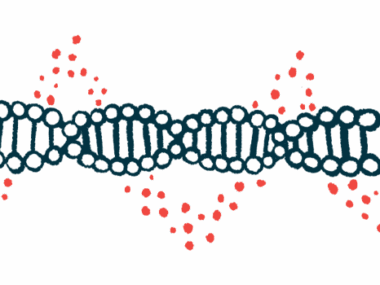A Few Cells With Defective MECP2 Can Cause Symptoms, Study Suggests
Written by |

Females with classic Rett syndrome have an inactivation of the paternally-inherited X chromosome — which most often contains disease-causing mutations in the MECP2 gene — in their cells, a study shows.
These findings suggest that while most cells in classic Rett patients may not have the mutated gene activated, the small portion of cells that do is sufficient to cause Rett symptoms, the researchers noted.
Future studies are needed to better understand the clinical implications of these results.
The study, “Analysis of X-inactivation status in a Rett syndrome natural history study cohort,” was published in the journal Molecular Genetics & Genomic Medicine.
Affecting females almost exclusively, Rett syndrome is caused mostly by mutations in one of the copies of the MECP2 gene, which is located on the X chromosome (one of the sex chromosomes). The resulting MeCP2 protein regulates other genes’ activities and is involved in nerve cell function and communication.
Most disease-causing MECP2 mutations occur spontaneously, or de novo, in the paternally-inherited X chromosome, while inherited mutations are mostly found on the maternally-inherited chromosome. De novo mutations are those not inherited that develop for the first time in the affected person.
While females have two X chromosomes (one from each biological parent), only one is needed for cells to function properly. Therefore, during development, one of the X chromosomes gets randomly silenced or inactivated in each cell, a process known as X-chromosome inactivation (XCI).
This means that female Rett patients typically show a mosaic pattern of cells producing a working MeCP2 protein, and cells with a defective or missing protein.
XCI skewing — or a preferential inactivation of one X chromosome over the other across the body — can occur due to the presence of a mutation in one of the X chromosomes, typically resulting in the silencing of the mutated chromosome. This likely reflects a protective mechanism against X-linked disease.
However, whether XCI skewing contributes to the clinical severity of female Rett patients remains unclear.
With this in mind, a team of researchers in the U.S. analyzed the X-chromosome inactivation patterns in blood samples from 287 female Rett patients and 33 females with Rett-like, X chromosome-linked conditions, as well as their mothers. They also analyzed potential links between XCI ratio and clinical severity.
Classic Rett was the most frequent diagnosis in the Rett group (81.6%), with 26 females showing atypical Rett. CDKL5 deficiency disorder (CDD), once classified as an atypical Rett form, was the most frequent Rett-like disease (48.5%).
Patients participated in two completed observational studies: the Natural History Study of Rett syndrome and Related Disorders (NCT02738281) and the Biobanking of Rett Syndrome and Related Disorders study (NCT02705677).
Information on the parental origin of the inactivated X chromosome was available for 263 cases. XCI ratios up to 79% are considered to represent random X inactivation, while 80%–90% ratios are classified as moderately skewed and 91%–100% ratios are classified as highly skewed.
Results showed that 82% of females with classic Rett had their paternally-inherited X chromosome preferentially inactivated, while this percentage was much lower for those with atypical Rett (58%).
An opposing pattern was observed in most (83%) females with CDD, in whom the maternally-inherited chromosome was the one inactivated.
Also, the average XCI ratio was slightly, but significantly increased in patients relative to their unaffected mothers (73% vs. 69%). More than a third (37%) of females with classic Rett and 22% of unaffected mothers had moderately to highly skewed XCI.
These percentages are significantly higher than those reported for unaffected newborns (5%) and adults (14%).
In addition, the most frequent disease-causing MECP2 mutations “were enriched in individuals with highly/moderately skewed XCI patterns, suggesting an association with higher levels of XCI skewing,” the team wrote.
Highly/moderately skewed XCI pattern was also more common among patients carrying more severe MECP2 mutations than among those with milder mutations (42.19% vs. 31.03%).
Further analyses in Rett patients showed that higher XCI ratios were associated with more severe disease — as assessed with two validated measures — but only in those with a maternally-inherited silenced X chromosome.
In these patients, greater skewing toward maternal X chromosome inactivation may mean that de novo disease-causing MECP2 mutations, likely located on the paternal X chromosome, “would be expressed more than the [healthy MECP2 copy], consequently causing a more destructive effect on the cell growth and survival,” the researchers wrote.
These findings “suggest that in classic RTT [Rett syndrome] the paternal X chromosome frequently carries de novo MECP2 [disease-causing] alterations while also being preferentially inactivated in XCI,” the team wrote.
This “seems to be the result of a protective mechanism against the mutated allele [gene copy], by natural selection of the cells with skewed XCI of the paternal allele,” the researchers added.
“However, it is interesting that an individual who is highly skewed toward inactivating the paternal (presumably mutant) chromosome still displays the clinical features of RTT,” highlighting that “a small portion of cells expressing the [mutated] allele is necessary to produce clinical RTT symptoms,” they wrote.
One possible explanation is that the effect of specific mutations may be much stronger than XCI, as having only a few cells producing a defective or missing protein may be sufficient for clinical manifestation, the researchers noted.
Another possibility is that other factors, such as potential genetic modifiers, might also influence the XCI-clinical severity associations. Genetic modifiers are genes or genetic variants that can increase or reduce the severity of a condition without necessarily causing the disease themselves.
Also, “the timing and location of the cells expressing defective MECP2 might also contribute to the clinical severity,” the researchers wrote.
“Further studies are needed to explore potential clinical implications of these findings,” they concluded.







